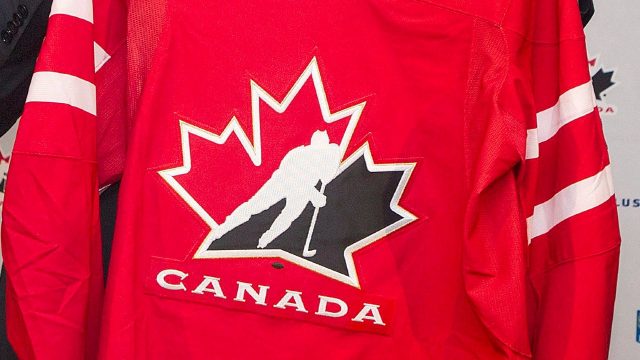
It’s eerie, despite being a throwback to a different time.
The first thing many will notice walking into Rogers Place in Edmonton for the IIHF world juniors this week is how white the ice looks. That brightness is caused by a rarity in hockey circles: No ads on the sheet. Just lines.
This decided lack of corporate presence — on the boards, there are only ads for Swiss watchmaker Tissot and the IIHF app, with the rest of the space dotted by blue and green stylized maple leaves — is part of the fallout from the cloud hanging over the 2022 tournament, the real-world effects of partners Tim Hortons, Telus, Scotiabank and Canadian Tire pausing sponsorship for Hockey Canada in the wake of sexual assault allegations.
This visual is a stark reminder that we could be experiencing change on a grand scale. This tipping point in the history of Canada’s national game means the tournament could lose money for the first time in the country’s history, which will have a trickledown effect on the grassroots programs supported by Hockey Canada.
Adding to the wakeup call are the very small, and, in some cases, non-existent crowds. A pre-tournament game on Tuesday between Canada and Sweden, for example, was atypically closed to fans, pucks off glass and players calling for a pass in two languages the only sounds.
Game attendance figures from early in the tournament were not readily available, but reports on social media and from those in attendance indicated tiny crowds. For instance, a mere handful of fans had turned up for the 8 p.m. local face-off for Tuesday’s USA-Germany game.
Over the last two decades, average attendance when Canada has hosted the tournament has ranged from 6,600 to more than 14,000 per game. Anything outside North America typically draws between 2,000 and 7,000.
A source familiar with Hockey Canada’s operation told Sportsnet that owing to the tournament being rescheduled from its usual December and January dates to the summer, the organization “never expected big crowds.”
Still, the small turnout will have a significant impact on the revenue the tournament generates, which in turn conceivably could mean less money for the programs Hockey Canada supports, a concern expressed by the women’s national teams earlier this week.
Also looming is the question of potential refunds to sponsors who paid for banners and such for the first 2022 tournament, in December, and were given the option of applying that committed money to the rescheduled tournament in August. With the rescheduled tournament relatively ad-free, that could mean refunds are due to some corporate sponsors, meaning even less revenue from Hockey Canada’s most lucrative event.
“Good question,” the source said. “Answer probably still coming.”
The controversy surrounding Hockey Canada stemming from alleged sexual assaults involving players on two Canadian world junior teams is foremost in the minds of hockey fans these days, and that could be keeping fans away.
In addition, the summertime rescheduling forced by rising COVID-19 infections in December plus a variety of factors could be contributing to the diminished interest: This year’s tournament is missing several big-name players, including Shane Wright, Owen Power, Cole Perfetti, Kaiden Guhle and Juraj Slafkovsky. It is also absent entries from Russia and Belarus, which were banned by the IIHF for their countries’ roles in the attack on Ukraine.
Regardless of the reasons, the effects are real: When hosting the tournament, Hockey Canada relies on the world juniors for a significant portion of its annual revenue. And the majority of that, of course, goes toward funding its annual budget, which is estimated to be worth north of $100 million.
The source estimated the net revenue for Hockey Canada – after paying each participating team about $2 million for expenses and 10-15 per cent to the IIHF – is about $12 million to $15 million, with about one-third of that going to the Canadian Hockey League (ostensibly as compensation for the use of the league’s players) and about 20 to 25 per cent distributed to the 13 regional hockey associations across Canada. The remainder goes to operations for Hockey Canada.
As the source told Sportsnet, this confluence of factors could means this year’s world juniors will be looking at a loss, which would be unprecedented when the tournament is in Canada.
With the withdrawal or freezing of funds by the federal government — which make up roughly six per cent of the organization’s annual funding — and sponsors, Hockey Canada’s remaining major sources of funding come from minor hockey association fees, considered to be relatively insignificant, and TV rights fees.
“We recognize these World Junior Championships are going to look and feel different for fans for a few reasons: first, the COVID-19 pandemic delayed this tournament to August; and second, there is understandable scrutiny from Canadians of Hockey Canada and the culture of hockey,” a Hockey Canada spokesperson said in a statement sent to Sportsnet.
“Our focus is ensuring the players who have trained for the past several months can compete on this important stage – and for the fans to enjoy a positive experience. At the same time, we will continue to work diligently to address toxic behaviours – both on and off the ice – that conflict with what Canadians expect hockey to be through the implementation of our Action Plan.”
The financial picture for Hockey Canada will continue to get more complicated after the tournament, especially as more hearings in Parliament are expected in September. But knowing revenue would take a hit because of the summertime rescheduling, the source said the IIHF previously awarded Hockey Canada the 2023 world juniors to help make amends for expected shortfalls.
The host city for that tournament? Halifax, the site of an alleged sexual assault involving members of the 2003 Canadian world junior team.
–with files from Sportsnet’s Emily Sadler






